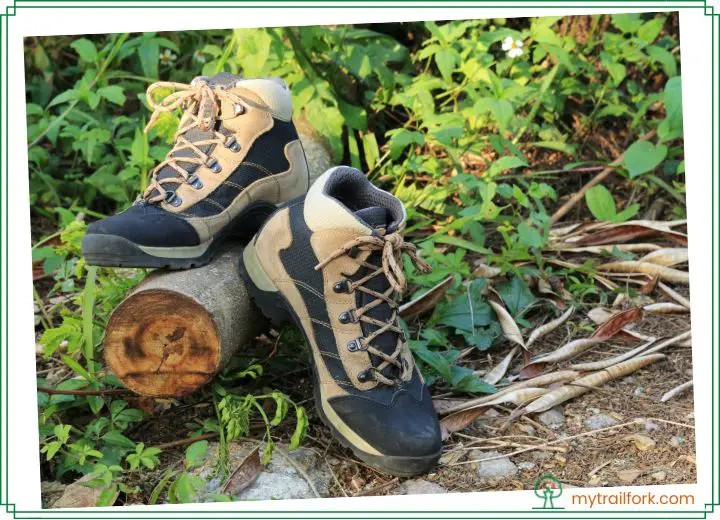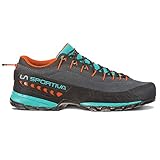Approach shoes vs. hiking boots: What’s the main difference? Which is more suitable for you? Let’s clear your query with valuable information in this post right now!
Top Rated Best Budget Approach Shoes and Hiking Boots for the money
Approach Shoes vs. Hiking Boots
When comparing approach shoes and hiking shoes head-to-head, which is the winner? Nowadays, there are many things in common between the two, as some approach shoes borrow decent features from hiking shoes and vice versa.
So knowing what is best for your trips can be a bit difficult. That is why we are here to help you categorize clearly between the two.
| Approach Shoes | Hiking Boots | |
| Pros |
|
|
| Cons |
|
|
Approach Shoes And Hiking Boots: Head-To-Head Comparison
Now, let’s dig into details of the differences between Approach Shoes And Hiking Boots. Each factor is important as it affects your final decision.
Hiking Boots
Hiking boots are hard-wearing, have soles that deliver a decent grip on slippery terrains, and feature one reinforced toe box to give your pinkies protection.
They are more protective and durable than trail-running and hiking shoes but heavier and hotter to wear. They offer ankle support that other shoes do not usually have.
Approach Shoes
Approach shoes are designed for use on semi-technical, long approaches to climbs, which gives them such a name.
The body of those shoes is more of the same running shoes than climbing ones as they need to be comfortable for any long approach.
The significant difference between approach shoes and trail runners is the sole.
These shoes are sold in the same rubber as climbing ones, making them especially grippy on rocks. Their sole typically extends above the toe box and usually surrounds the back of the heel.
Waterproofness
Hiking boots and approach shoes are only waterproof if they are made from some type of waterproof linings, such as Gore-Tex or equivalent.
Many approach shoes do not come with linings as climbers usually rock climb when the weather is fair.
Comfort Advantage
Regardless of which hiking boots and approach shoes you choose, you’ll get maximum comfort as long as you get the suitable model.
If you move quickly and carry light loads (especially on well-maintained trails), the approach shoes would work well as they offer a great combination of flex, cushion, and nimbleness.
For people with sustained packs (above 25 pounds) or covering more technical ground, the support and stiffness of hiking boots will be the most comfortable option.
Generally, it significantly depends on your goals, such as what kind of terrain you want to cover, how fast you want to move, and what you are comfortable with.
Stiffness
Once again, it is very hard to evaluate the stiffness of hiking boots and approach shoes, as it significantly varies from model.
Many approach shoes come with a decent amount of rigidity across the soles, which helps with edging on small rock footholds, but it may vary considerably.
Meanwhile, most hiking boots are pretty supportive and probably stiffer than typical approach shoes.
Weight
It is also hard to generalize about their weight, but the majority of approach shoes are lighter than most hiking boots, which are made for heavier wear.
The weight of hiking boots and approach shoes also differs a lot, and there are much heavier and very light models of each type, depending on what they are made for.
Various approach shoes are lighter since climbers often clip these shoes to their harnesses to carry on long climbing.
Yet, some shoes are made for carrying loads into mountains that might be so heavy to carry on the harness.
Durability
Approach shoes tend not to last as long as hiking boots because of the used softer rubber compound.
Hiking boots feature harder rubber compounds that are specifically made to be more durable, allowing them to last longer.
Several approach shoes are made so that you can re-soled them, similar to climbing shoes. Although they also wear out quickly, they can be easily re-soled.
Hiking boots are typically highly durable and last longer, made for muddy and wet trails, and soled with decent sustained wearing rubber.
Grip
Approach shoes are ideal on rock surfaces than hiking boots as approach shoes feature less aggressive lugs and much stickier rubber. They allow you to get more rubber on rock surfaces. More rubber gives more grip.
But many approach shoes do not perform as well on the muddy trail as hiking boots, which come with soles with deeper lugs made for grip in the mud.
Final Verdict: Hiking Boots And Approach Shoes
Generally, what you pick to buy depends on what you want to do.
To keep things simple, we recommend hiking boots for a hiking trip and approach shoes for climbing.
If you are one of the long-distance day hikers or thru-hikers carrying a light load, approach shoes are worth considering.
Approach shoes are also ideal for ridge traverses and hikes with peak bagging.
However, if you are an avid backpacker or hiker who needs a great combination of comfort, protection and support, traction, and durability, proper hiking boots are the way to go.
Also, if you spend most of your time on typical hiking terrains, hiking boots will definitely last longer and offer more support and grip on muddy and wet terrain.
FAQs
The answers and information below will help you gain more insights into the traits and qualities of Hiking Boots And Approach Shoes.
What Is the Purpose of Approach Shoes?
Approach shoes are the perfect combination of climbing and hiking shoes.
They are designed for the approach to the rock-climbing areas. That means they must both walk on the forest floors and navigate on slippery rocks so that they can be helpful on any part of an approach.
Are Approach Shoes Good for Everyday Use?
Not only helpful in getting to the base of a climb, but approach shoes also work well for scrambling, light hiking, or everyday use. It is okay to wear these shoes to run errands around town, walk with your dog, and more.
Can Approach Shoes Be Used for Climbing?
Approach Shoes are useful for climbers as they are an essential piece of footwear that offers traction and stability on rock but comfort for miles on the trails.
These shoes feature a lugged rubber sole, making them suitable for various surfaces.
Are Approach Shoes Necessary?
Not all climbers need approach shoes. For mellow and short walks to the crag, hiking shoes, or even sandals, are good enough.
How Long Should Approach Shoes Last?
Approach shoes can last roughly 300 to 500 miles before losing a significant amount of performance.
That distance range is equivalent to about five to eight months of moderate use (15 miles for each week).
Should Approach Shoes Be Tight?
Approach shoes should fit nicely like hiking shoes, with a bit of room for toes to move around, allowing you to get more comfortable while hiking, especially for long distances.
What Are the Pros And Cons of Hiking Boots?
Key Benefits
- Durability.
- Stability.
- Good all-around traction.
- Foot and ankle protection.
- Warmer for cold-weather hikes.
- Slough off mud, snow, and water.
Key Downsides
- Require break-in period.
- Heavier and bulkier.
How Long Should Hiking Boots Last?
Some manufacturers recommend their consumers replace their hiking boots every 350 to 500 miles depending on usage, or every three to six months.
This milestone might be accurate, depending on the kind of hiking hikers enjoy and the conditions in which the hiking boots were utilized.
Are Approach Shoes Good for Trail Running?
The answer is yes, as approach shoes are versatile. Besides providing a sticky grip on rocks, approach shoes are also made for long days on the trail.
They have great features of climbing shoes, hiking boots, and trail-running shoes: supportive, comfortable, and sticky. That is a powerful trifecta.
How Do You Store Hiking Shoes?
You should store hiking boots in a dry, cool place when you are not using them.
Avoid putting them in a hot garage or attic since extreme heat can harm their material, significantly lowering their lifespan.








